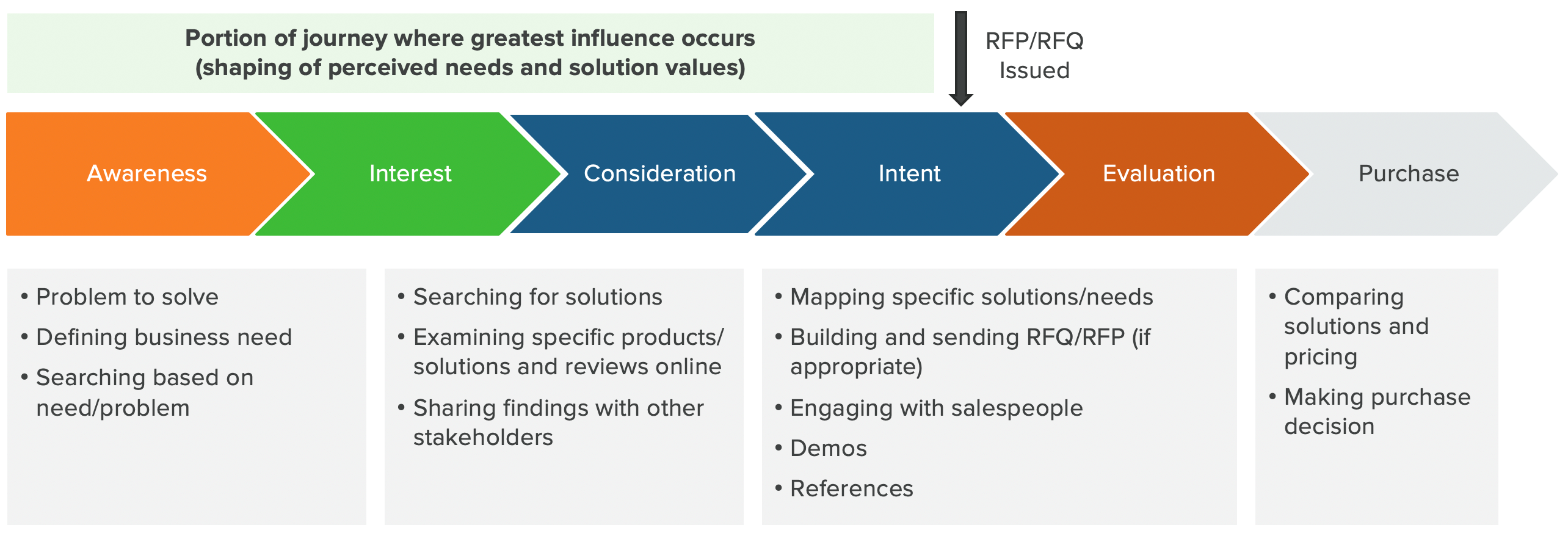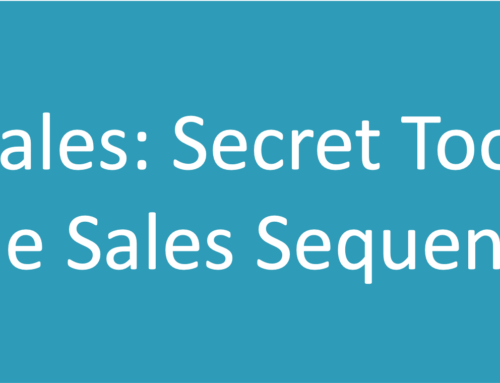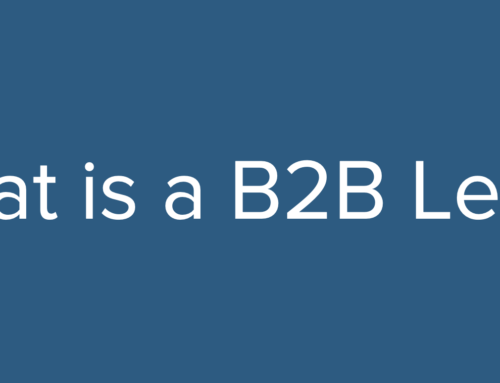This third blog post of the “7 things a CEO needs to know about marketing” series focuses on the B2B buyer journey. You may believe your company sells stuff to the market – like your products or services, however, that is your seller view and not a buyer view. You indeed have products and services, and you definitely engage in activities that lead to sales but the truth is people are buying what they need or want FROM you.
You may be thinking “yada, yada, yada … this is just wordplay or nuance.” I would respond, no, this makes a big difference in how you view and market to prospects and how you organize sales activities once you fully accept that prospects are in control on a buyer journey. You are not in control when selling TO them.
B2B Buyer Journey
There are many versions of the buyer journey that you may find if you search that term. Most are organized into about five to six stages and labeled in a similar manner to the one I have created in Figure 1.

Buyers start their journey as they become aware that there is a pain point, a need, a reason to search for a solution or product to solve a problem. As you review the stages and the associated notes you can see a buyer progresses to search for and consider different alternatives before developing some actual “intent” to purchase where they develop an RFP/RFQ (for some businesses) or simply informally or formally know what features/benefits they are particularly looking to purchase. This is where they begin evaluating actual products or services and ultimately make a decision.
Buyers start their journey as they become aware that there is a pain point, a need, a reason to search for a solution or product to solve a problem. Share on XKey Things to Know about your Buyers and their Journey
Over the years, both through various readings related to the buyer journey as well as experience, I have collected a few key facts that I believe are significant to remember regarding B2B marketing and your strategy/plan to sell into the B2B marketplace.
Real influence on buying occurs early in the process
In Figure 1, the light green box above the journey blocks points out that the earlier stages are where there is the MOST potential to influence what B2B buyers will ultimately purchase. When you are engaged with prospects as they are considering the real pain points and the types of solutions that can solve problems, you have the opportunity to influence this approach. By the time someone is creating an RFP/RFQ, they have formed a fairly solid view on what products or solutions might fit. Your ability to influence this, especially if your product does not fit, is quite limited.
Buyers are more in control of sales engagement today
The second fact you need to consider actually goes along with this first point. Prior to the widespread availability and the use of search engines, buyers in the B2B market rely more on proactive salespeople. They readily engage salespeople in the earlier buying stages to educate and keep them informed on general industry trends, changes in technology, and potential solutions to problems.
However, as Figure 2 demonstrates, research reveals that today’s B2B buyers are waiting much longer in the buyer journey before actively inviting sales to engage.

Meaning that without a proactive push on your part, many buyers would wait to engage with you until a buying stage where you have little impact on what they want to purchase. You only hope they include your product on their short list, basically, you are just bidding against others on a list.
B2B marketing must elicit earlier stage prospect engagement
Marketing today needs to target engaging buyers early in their journey to capture their interest. Allowing them the opportunity to invite your salespeople into a discussion about their needs, interests, and demonstrate the value offered through your products and services. You cannot afford to wait until they are “sales ready” on their own. You will risk enagement at the RFP/RFQ stage or bidding/price stage, not the value stage.
You may ask yourself, ok, what does this type of marketing look like? It is all about offering the right content. Content that educates so that prospects in the awareness stage can clearly feel that you understand their challenges and pain points. Content at the interest stage clearly demonstrates you understand how to solve the business problems they face. Content at the consideration stage shows how other customers have found value in what you offer.
Most B2B companies have a lot of content for the later stages (e.g., product brochures, speeds and feeds on “what”’ your products do, catalogues, pricing, etc). The questions you as a CEO should be asking in this area are, what types of content do you have for the earlier stages and what kinds of marketing tactics do you use to engage prospects into “conversations” about their needs?
Sales engagement and the buyer journey
This brings us back to where I started. The goal of B2B marketing should be to generate opportunities for sales to engage in conversation (i.e., a reason to engage the prospect) with a prospect. This may be a significant shift for sales thinking as well and needs to be managed.
If you consistently hear from sales, and you likely do, that they are not getting good leads, you should gather your sales leadership and probably the sales team to dig into that conversation more deeply. When I hear complaints about leads, the first question I ask is “why are these not good leads?” When I hear the response that these leads are ready to buy, I immediately know there needs to be an adjustment on the responsibility of sales.
If you sell more commodity products, then yes, I think sales could expect more “sales ready” leads because usually the demand is fairly established, and you are always marketing and selling more towards the “intent to buy” stage of the journey.
However, for those of you that lead companies selling products or services that have longer sales cycle and generally higher value/margin, your sales team needs to understand that the primary goal of marketing. That goal is to find new prospects or existing ones that match the market segment profile and generate opportunities for sales to have a conversation with those prospects. B2B sales conversions are usually the result of prospects buying from (a) salespeople they know – that have built a relationship with them over time, and (b) salespeople they trust – those that have been persistent to have conversations about the value of what they provide.
One example I will share: I worked with two customers that had very similar types of offerings to very similar markets. One customer held a series of webinars over the course of about four to five months and generated hundreds of leads. They sent those leads to sales (those who attended the webinar were sent as “hot” leads, and those registered but did not attend were sent as “FYI Only”). These prospects were obviously ALL interested in the topics presented and open to a conversation about what they would like to learn and how a salesperson could assist them. This generated about $2M in business from those leads.
As for the second customer, they sent ONLY the webinar leads to sales (very small number) that “asked” to speak with sales on the registration form. They sent all of the remaining webinar registrants/attendees to an inside sales pre-qualification group. That group “disqualified” 97% of those leads because they could not reach them. So, even though these prospects matched their profile and were highly interested in a topic directly related to the products/services they sold, their outside sales team never saw about 95% of the total leads. This company only generated about $300k from their webinar investment with roughly the same number of leads. The likely difference in results could be because their outside sales team not having the opportunity to start a conversation with the 95% unseen leads.
If you just sell to them, you are missing opportunity
Take a moment and look at how your marketing and sales groups work together. Do you have a sales team that is just hunting for prospects or waiting for marketing leads that are ready to be “sold to”? If so, they are missing an opportunity to start meaningful conversations with qualified future buyers that are at the beginning or middle of the buying journey.
Instead of just selling to them, build a marketing and sales culture around finding the right buyers and insist that sales engage to build long-term, deep relationship with those buyers and their companies. Your sales team will then be influencing the value those buyers are looking for and more sales will result from those trusted relationships.
RELATED CONTENT
7 things every CEO should know about marketing series:
#1 The Ante
#2 Not all marketing is the same
The One-Person B2B Marketing Department Playbook – Chapter 5 – Marketing Content: Baiting the Hook






